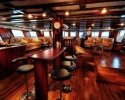S/Y Philippine Siren
Did you always want to explore some of the worlds best diving? Would you like to see Manta Rays, Whalesharks and Hammerhead Sharks? Do you like the thrill to dive World War II wrecks? Have you wanted to see Pigmy Seahorses, Flamboyant Cuttlefish, frogfish and Ornate Ghost Pipe Fish? We have four distinct trips to the Islands and dive sites of the Philippines that will whet the apetite of even the most seasoned of divers.
The Philippines is an archipelago of 7107 tropical islands and islets in deep blue waters that contain some of the richest marine life-system on earth and is second only to Indonesia as the largest arcipelago in the world. Only 2000 are inhabited, and around 2500 of them are not even named. Seperating the South China Sea and the Pacific Ocean, with the Celebes Sea to the South and to the East lies the Philippine Trench, one of the world's deepest points, reaching 10,500m below sea level.
The S/Y Philippine Siren welcomes up to 16 guests aboard each trip, and has the following itineraries:
South Visayas from Macatan to Apo Island
Year round - 10 day 10 night
Taking in Cabilao Island which is home to some of the best diving in the Philippines and is particularly noted for sightings of Hammerhead Sharks. Apo Island considered by many to be the most successful marine sanctuary in the Philippines. Coral growth has benifited greatly and the vast number of fish species is astounding. Jacks, barracuda, sweetlips, Bumphead Wrasse, and lots of turtles can all be seen. There is a clownfish city with hundreds of Tomato Anenome fish living together . At the marine sanctuary dive site, Manta Rays are a common site. Dumaguete on Negros allows possible sightings of frogfish, Ornate Ghost Pipe Fish as well as many other small critters. The Pier is an awesome dive and offers the opportunity to see Mandarin Fish. Olongo island, Capitancillo Island and Mactan Island all offer the possibility of seeing Hammerhead Sharks and Whalesharks.
Southern Leyte around Bohol
January to April - 10 day 10 night
Mactan Island and Olongo Island offer the possibility of sightings of large pelagic such as Whitetip and Greytip Reef Sharks as well as Hammerhead Sharks. Sogod Bay is world famous for sightings of Whalesharks. Pangalo and Baliqasac Islands offer up Manta Rays, Hammerhead Sharks and Whalesharks. Cabilao Island is home to some of the best diving in the Philippines and is also noted for sightings of Hammerhead Sharks.
Borocay via Apo Reef to the wrecks of Coron
December to February - 10 day 10 night
Dives around Borocay and Carabo Island include Yapak where sightings of Grey Reef Sharks, Whitetip Reef Sharks, Hammerhead Sharks, Manta Rays and Eagle Rays are all possible. Maniquin Island is a truly wonderful dive location and caters to all divers whether into large pelagic such as shark and Manta Rays or soft and hard corals, and fish life of all types. Apo Reef a UNESCO world heritage site is by many considered among the best diving in the Philippines. The whole North East side of Apo Reef consists of drop off's and overhangs where Whitetip and Grey Reef Sharks, turtles, barracuda and shoals of snapper are common. There is a turtle sanctuary on Apo island. The Japanese World War II wrecks around Busuanga Island, particularly in Coron Bay, have been one of the Philippine diving best kept secrets. Twelve wrecks have so far been located in diveable depths and we shall dive many of them.
Tubbataha Reef National Marine Park
March to June - 7 day 7 night.
Proclaimed as a National Marine Park on 11/08/1988 and inscribed as a UNESCO World Heritage site in 1993, in recognition of its outstanding universal value in terms of marine life species diversity and richness. 182km South East of Puerto Princessa on Palawan Island, the Tubbataha Reef in the Sulu Sea offers some truly amazing diving only accesible by liveaboard. These reefs consist of vertical walls or near drop off's rising out of great depths. The shallow reef tops are teeming with local reef fish; in many places stingrays, spiny lobsters, immature Manta Rays, turtles, Leopard Sharks and Guitar Sharks are common. The walls are covered in huge barrel sponges, gorgonian sea fans, soft corals, hydroids, black corals. In deeper water shoals of angelfish, butterfly fish, pennant fish, rainbow runners, Moorish Idols, fusiliers, jacks, snappers and sweetlips follow you around. Large trevally, tuna and barracuda s well as Grey Reef Sharks and Whitetip Sharks patrol. Giant Manta Rays and Eagle Rays fly overhead and turtles and groupers large and small including Napoleon Wrasse pass by.
How to get there:
The South Visayas and Southern Leyte trips all start and end on Mactan Island which itself has an international airport, although this is likely to be listed as Cebu.
The Borocay, Apo Reef and Coron Wreck trip alternates the start and finish between Borocay and Palawan.
Flights are available to Puerto Princessa via Manila and via Singapore. You can fly to Borocay via Kalibo or Caticlan from the Manila Domestic Airport. From Kalibo Airport you need to catch a bus (right outside the airport) to the pier in Caticlan which takes approx 1.5 hours. You can also fly direct to Caticlan Airport which is a 15 minute drive to the pier. From the pier you take a ferry taking 30 mins over to Borocay.
The Tubbataha Reef trips start and end in Puerto Princessa and flights are available via Manila or Singapore.
- English
- | Nederlands
The first real-time diving holidays site in the world...
Comments
add your comment
Destinations
SEARCH
DIVE THEMES
DIVE EQUIPMENT













